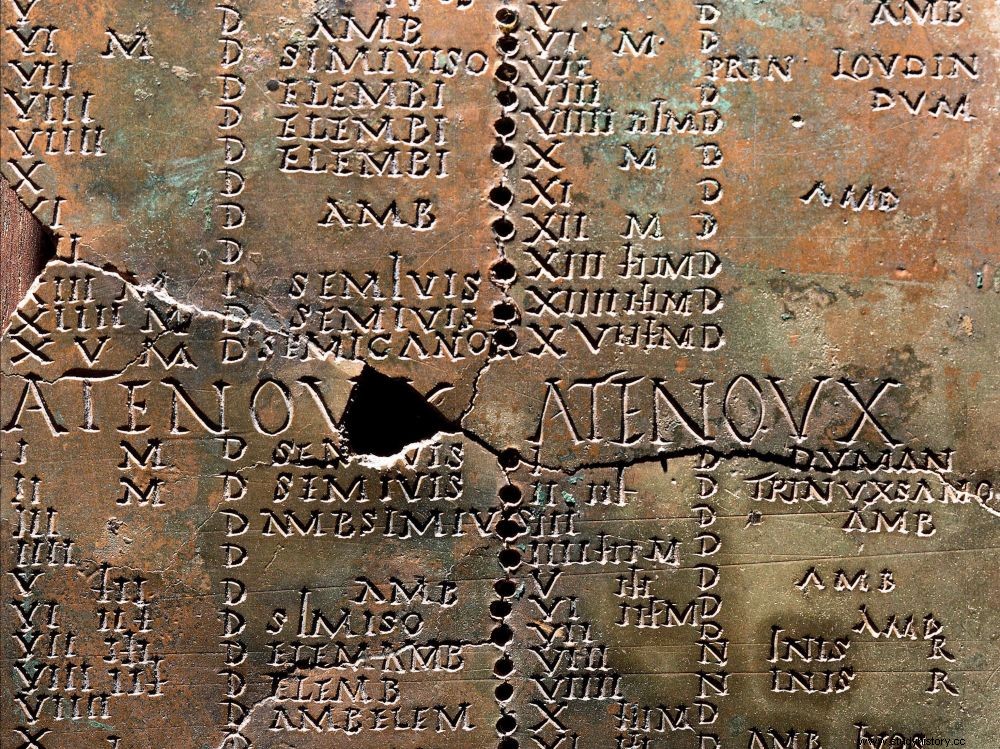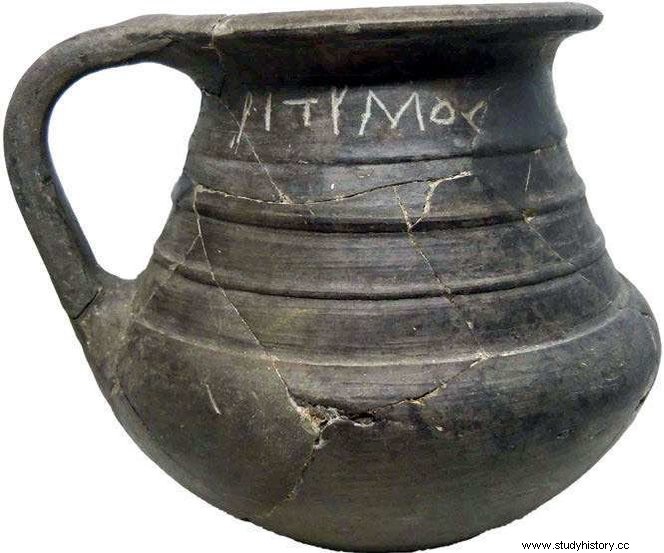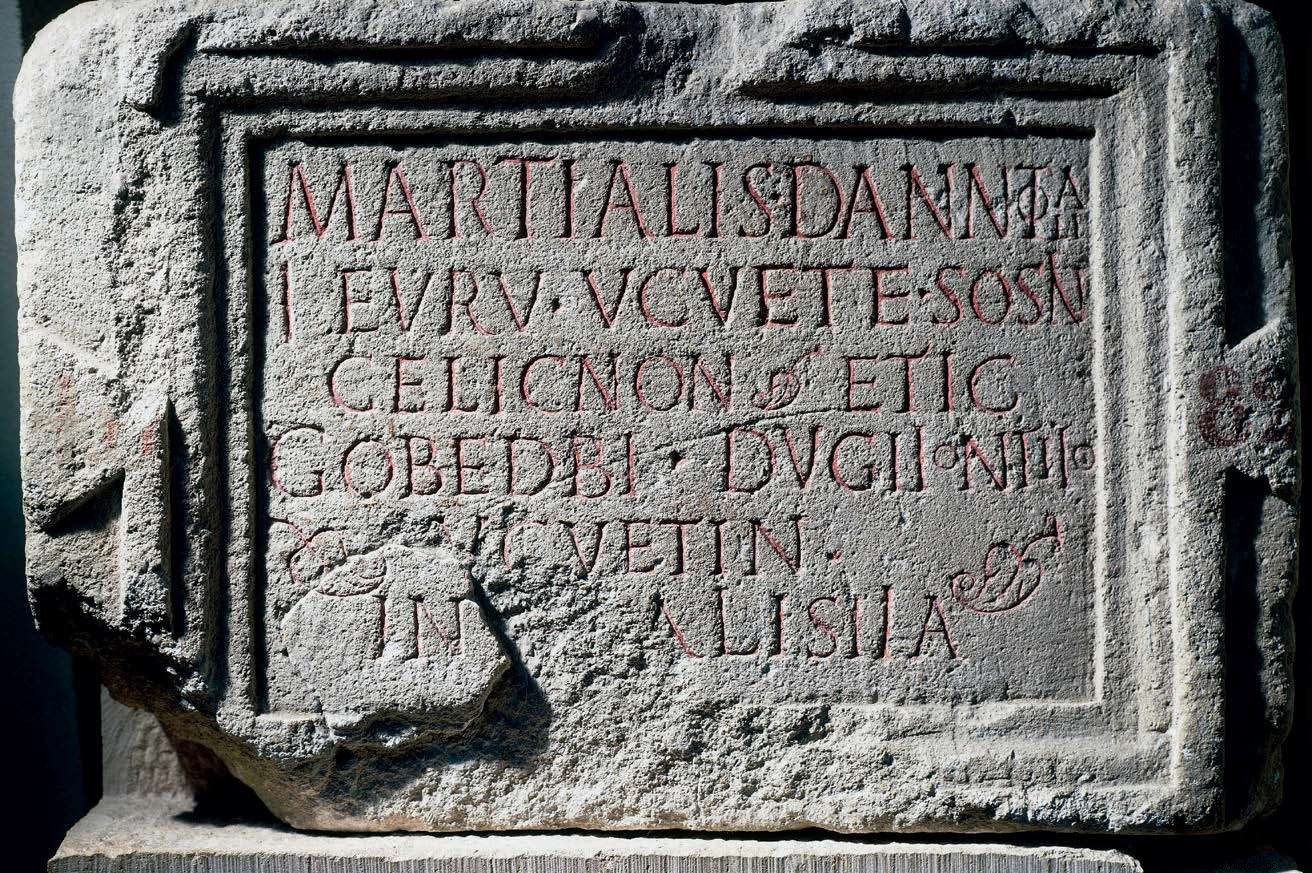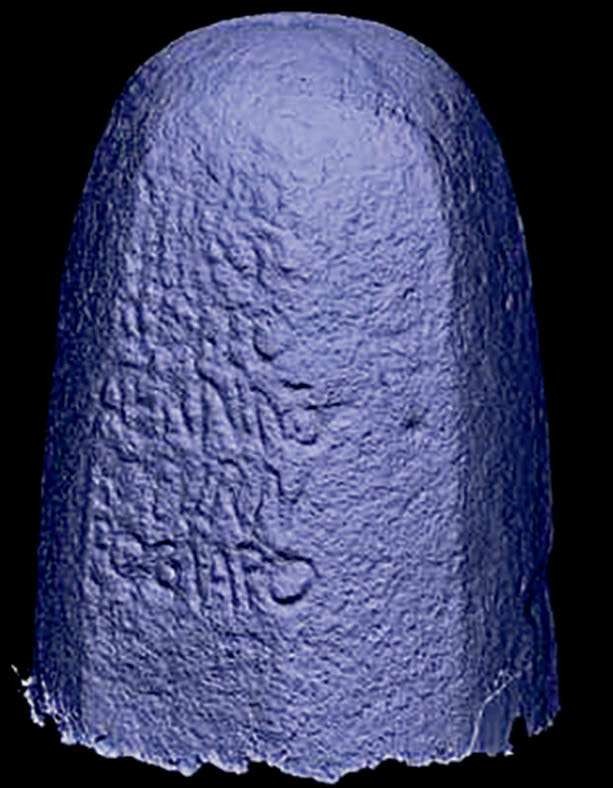Contrary to popular belief, the Gauls used writing. A vast research program provides for the next online publication of all the Gallic inscriptions collected to date on our territory. Here's a taste of what it will reveal.

The "Coligny calendar" (1st century) is one of the 800 Gallic inscriptions collected to date in France.
It wasn't written in sand… And yet, Quebec filmmaker Denis Villeneuve would probably be surprised to learn that the title of his film "Dune" (2021) inspired by the eponymous science fiction novel (1965), by writer Frank Herbert, was a word of Gallic origin! A name born from dun or dunos which designates the vertices, and which is found in dunon (citadel, oppidum, hill). Latinized to dunum , it gave "dun ", present in the toponymy of Issoudun in the Centre-Val de Loire - the ancient Uxellodunum (the high fortress) -, or even of Lyon, Lugdunum (the hill of Lug). Traveling word passed from Gaulish to Germanic, then in Middle Dutch, "dune " then came back in the French language as well as in the English.
But that's not all. Beyond the few hundred words of Gallic origin that linguists track down in our language - like lark, embassy or oak -, a handful of young researchers have embarked on the census of all the inscriptions left by the Gallic peoples for more than 2000 years. Indeed, "against the myth of a Gaul populated by inhabitants without writing, the Gauls left hundreds of written documents ", explains Coline Ruiz Darasse, epigraphist, CNRS researcher at the Ausonius Institute (Bordeaux-Montaigne University). Short texts found, sometimes engraved on stone (a hundred copies) or on pottery, even on leaves of lead - any texts on skin, wax, wood, bark or other perishable materials that have not been preserved, if they ever existed.
At the head of this important project, the researcher coordinates the putting online of a platform where the Computed Compilation of Gallic Inscriptions (RIIG) will be hosted, i.e. the publication of all 800 Gallic inscriptions, a language belonging to to the continental Celtic branch of the Indo-European linguistic tree, collected to date in France - coinage and their symbolism not included in this program. Translated and enriched, these writings are supplemented by scientific equipment collected from archaeologists, historians, linguists and epigraphists over the past thirty years. "For the Gallic world, we of course have the " Caesar's Commentaries" and other historical texts, but thanks to the inscriptions we have direct access to the thought of the inhabitants of Gaul from the end of the 3rd century BC to the 3rd century AD . “, continues the specialist in languages of fragmentary attestation, scholarly name of the discipline.
This article is taken from Science et Avenir - La recherche n°899, dated January 2022.
It wasn't written in sand… And yet, Quebec filmmaker Denis Villeneuve would probably be surprised to learn that the title of his film "Dune" (2021) inspired by the eponymous science fiction novel (1965), by writer Frank Herbert, was a word of Gallic origin! A name born from dun or dunos which designates the vertices, and which is found in dunon (citadel, oppidum, hill). Latinized to dunum , it gave "dun ", present in the toponymy of Issoudun in the Centre-Val de Loire - the ancient Uxellodunum (the high fortress) -, or even of Lyon, Lugdunum (the hill of Lug). Traveling word passed from Gaulish to Germanic, then in Middle Dutch, "dune " then came back in the French language as well as in the English.
But that's not all. Beyond the few hundred words of Gallic origin that linguists track down in our language - like lark, embassy or oak -, a handful of young researchers have embarked on the census of all the inscriptions left by the Gallic peoples for more than 2000 years. Indeed, "against the myth of a Gaul populated by inhabitants without writing, the Gauls left hundreds of written documents ", explains Coline Ruiz Darasse, epigraphist, CNRS researcher at the Ausonius Institute (Bordeaux-Montaigne University). Short texts found, sometimes engraved on stone (a hundred copies) or on pottery, even on leaves of lead - any texts on skin, wax, wood, bark or other perishable materials that have not been preserved, if they ever existed.
At the head of this important project, the researcher coordinates the putting online of a platform where the Computed Compilation of Gallic Inscriptions (RIIG) will be hosted, i.e. the publication of all 800 Gallic inscriptions, a language belonging to to the continental Celtic branch of the Indo-European linguistic tree, collected to date in France - coinage and their symbolism not included in this program. Translated and enriched, these writings are supplemented by scientific equipment collected from archaeologists, historians, linguists and epigraphists over the past thirty years. "For the Gallic world, we of course have the " Caesar's Commentaries" and other historical texts, but thanks to the inscriptions we have direct access to the thought of the inhabitants of Gaul from the end of the 3rd century BC to the 3rd century AD . “, continues the specialist in languages of fragmentary attestation, scholarly name of the discipline.
Very imaginative, the Gauls wrote for five centuries using the alphabet of the Greeks (Phocians) from the 3rd century BC, present in Marseilles (Massalia) since 600 BC, which gave Gallo-Greek (more than 400 inscriptions collected); then, from the 1st century BC, using the Latin letters of the Romans, Gallo-Latin. "These texts show us how much the Gauls, to write their language, were able to adapt to existing graphic systems ", adds Hugo Blanchet, specialist in ancient linguistics and participant in the ongoing project at Bordeaux-Montaigne University.
"Gaulish, a Celtic language made up of several dialects", by Coline Ruiz Darasse, epigraphist, CNRS research fellow at the Ausonius Institute, in Bordeaux
“The so-called Gallic language is a continental Celtic language attested in its written form since the very beginning of the 2nd century BC and whose last traces date from the 4th century AD. However, it was probably spoken long before in the territory of Gaul, where the La Tène culture (Second Iron Age) had been present since the 5th century BC. It is likely that the Celts of Gaul were already speaking a form of Gaulish. It is one of the so-called fragmentary attestation languages. Its main lines are known thanks to the inscriptions discovered and the comparisons made with other Celtic languages, especially those attested later (Irish, Welsh and Breton). Probably composed of several dialects in a situation of "intercomprehension", it seems to be the same for the old inscriptions (mainly Gallo-Greek) and the most recent (Gallo-Latin). If the study of proper names is well known for people, places or gods, the same is not true for the verbal system:less than ten verbs have been identified to date. ”
The 3D virtual reconstruction of the terminal in Plumergat (Morbihan) made it possible to highlight a text engraved in dedication to the "fathers of the terminal". Credit:RIIG ANR 19-CE27-0003
Lots of information on manners
The study of Gallic epigraphy is a field that arouses the enthusiasm of researchers, but also a great curiosity of the public. Hence the publication of these ancient quotations replaced in their archaeological and historical context for all the curious. With phrases such as:"Escengolati aniateios immi " ("I belong to Eskengolatios and must not be robbed! "), or even "Segomaros ouilloneos touutious namausatis eiorou belesami sosin nemeton " ("Segomaros son of Villonos, citizen of Nîmes, dedicated this sacred place to Belesama "). Two inscriptions over 2000 years old!
These ancient writings provide a lot of information on the population thanks to anthroponymy (study of people's names) with, for example, Segomaros, Martialis or Escengolatos and on patronymic filiations such as "Untel fils de Untel ", in a world where there is no family name and where only that of the father is attributed; but also on place names with toponymy (like Namausus for Nîmes), or even on the names of divinities (theonymy) such as Cernunnos, the horned god, Belisama, the Gallic Minerva, or Toutatis, the god of the Touta tribe. along the Rhône valley, in Paris, in Berry, Puy-de-Dôme, or even in the Morvan massif where 40 Gallo-Greek graffiti were found on the oppidum of Bibracte, the capital of the Aedui (in Gaulois, "the beaver mountain") and on the very site of the Alésia site (Alise-Sainte-Reine), in Côte-d'Or.
These quotations are most of the time votive dedications, thanks addressed to the deities, or even epitaphs on tombstones. "A certain number of deities of the Gallic pantheon are also known thanks to these inscriptions. This is the case of Taranis, in Orgon; of the Glanic Mothers in Glanum (Saint-Rémy-de-Provence); of Belenos in Saint -Chamas (the three located in the Bouches-du-Rhône, editor's note) ; or the blacksmith god Ucuetis, whose worship was honored in Alesia ", continues Hugo Blanchet.
Sometimes incised on steles more than 2 meters high - recorded in 19th century documents that have since disappeared - these Gallic inscriptions testify to the existence of a monumental and honorary practice of writing in the image of this that we met in the rest of the ancient world, in Greece or Rome. These texts thus give an idea of the multilingualism and cultural multigraphism with which the Gauls functioned. "As an example, a funerary stele from the 1st century BC found in Velleron, in the Vaucluse, and its dedication: “Kaios indoutilo samolatis anektia oualete” (“Caios Indoutilo and his wife Samolatis, daughter of Anektos, Hail!”. It allows the name to be read both Gallic and Latin of the owner, that of his wife, the final greeting - Oualete -, a Latin word, and the entire inscription written using the Greek alphabet. With this incised stone alone we have evidence of the intertwining of identities, as much as graphic systems and the language spoken at that time. A real snapshot of the adaptation with which the Gauls functioned! ", enthuses Coline Ruiz Darasse. A Gallic world which was not a homogeneous "nation", but rather dozens of complex tribes and confederations (Éduens, Séquanes, etc.) whose names have been transmitted to us by the Roman elite and by Caesar at the time of the conquest, in his "Comments on the Gallic Wars" (1st century BC).

On this Catalan goblet from the 2nd century BC is inscribed in Gallo-Greek the Gallic name Ritumos. Credits: ZIEM MUSEUM, MARTIGUES
From erotic formulas to vengeful tablets
Among the supports of Gallic writings, graffiti on common pottery are the most numerous and testify to the practice of writing by a fairly large part of the population. "These are often very modest property titles of the type “I belong to”. Or just a name like Attilos, or Aunisolos, titles that make up three quarters of the corpus ", specifies Hugo Blanchet. As in all Antiquity, ribald mentions appear from time to time, in particular on drinking objects found in the context of banquets such as jugs with spouts in the shape of a phallus (bissu , in Gallic). But not only. Some of these graffiti have been identified on spindle whorls, feminine accessories for spinning wool, sometimes carrying explicit formulas:"May I be ridden " !
“Another group of lead sheet inscriptions are the so-called defixion tablets ", continues the epigraphist. In the ancient world, these malevolent inscriptions were devoted to the infernal deities. Inexpensive and widespread, lead was easy to incise. Imprecations, bad spells, magical practices, everything was good to doom the addressee of the tablet, promising it a dreadful end. The Gauls used them in the same way as many peoples of Antiquity. One of these lead tablets containing a text of magic in Gallo-Latin (1st century AD. -C.), found in rouvée in L'Hospitalet-du-Larzac (Aveyron), is among the most famous. We discover there a certain "Severa" - "witch by writing" - summoning evil forces .
"These vengeful tablets were placed in freshly dug graves, for it was believed that like messengers, the newly buried dead would more quickly deliver these curses and anathemas to the infernal deities they found in the underworld “, says Coline Ruiz Darasse. About fifteen European researchers are currently collaborating on this program which should be accessible in its entirety from June 2022.

This 1st century stele called "Pierre de Martialis", discovered on the site of Alésia in Alise-Sainte-Reine (Côte-d'Or), bears a dedication in Gallo-Latin. Credit: AKG IMAGES
Asterix, Obelix… why these -ix?
If the names of the Gauls of Asterix all end in -ix, it is probably in reference to the most famous of them, Vercingetorix (supreme king of warriors). However, in Vercingetorix, the last element is not -ix, but -rix! This is the word meaning "king" in Gaulish (cousin of the rex Latin, and rajah Indian, also of Indo-European origin). By extension, the Celtic element -rix (king) was used to make Gallic names, probably taking the more general meaning of "powerful, rich in". Thus:Eskingorix (king of warriors), Comartiorix (lord of bears), Bellorix (rich in strength) or even Biturix (king of the world), hence the people of Bituriges whose name gave that of Bourges and Berry.
These French words from Gaulish
"The number of words in the French language derived from Gaulish is difficult to estimate" , according to Hugo Blanchet, researcher at Bordeaux-Montaigne University. It is probably undervalued because Latin has already borrowed from Gaulish. And French does not have a monopoly on the heritage of Gaulish, the Gallic lexicon also being present in Franco-Provençal, Occitan, Italian, Romansh, or Catalan.
BUDGET (from Gaulish bulga )
The Gallic word bulga "bag, purse" is the source of the French words "bogue" (from chestnut) and "bouge", which originally means "bag", from which we formed the diminutive "bougette" (small bag, purse) that we will borrow the English in the form budget ... which gives the French "budget".
EMBASSY (ambactos)
Attested also in the Middle Ages in the form "ambasse" (which gave the English embassy ), the word "embassy" is a borrowing from Old Italian ambasciata from old Occitan ambaissada , from Low Latin ambactia ("message"), derived from Gaulish ambactos ("servant").
PATH (roads)
The word "path" goes back to the Low Latin camminus (Spanish camino , etc.) from the Gaulish cammanos , "path", derived from a verb cang /cing "to walk" found in the word cinges ("who walks, warrior") present in the name of Vercingetorix!
OAK (cassanos)
Cassanos is frequent in toponymy:thus, Chassenon, Cassinomagos, "oak market", Chasseneuil, Cassanoialon, "oak clearing", etc.
TO FIND OUT MORE
"The Indomitable Gallic words in the French language ", Jacques Lacroix, 2020.
"Illustrated alphabet of travel words ", Hugo Blanchet, 2021.

